J-PARC Project Newsletter No.92, October 2023 dispatch
★☆-------------------------------------------------------------------------------------------------
J-PARC Project Newsletter
No.92, October 2023
Japan Proton Accelerator Research Complex under joint operation by the
High Energy Accelerator Research Organization (KEK) and the Japan Atomic
Energy Agency (JAEA)
http://j-parc.jp/index-e.html
-------------------------------------------------------------------------------------------------☆★
HEADLINES AND CONTENTS
1. [Overview]
J-PARC STATUS AFTER THE FIRES.
USER'S COUNCIL BY INDUSTRIAL USERS SOCIETY FOR NEUTRON APPLICATION.
PR ACTIVITIES.
2. [Accelerator Division]
SUMMER'S MAINTENANCE IS IN PROGRESS AT THE ACCELERATOR FACILITIES.
THE INTEGRITY OF ALL POWER SUPPLIES WAS INVESTIGATED AND MORE INTERLOCKS WERE REINFORCED.
3. [Particle and Nuclear Physics Division]
ON THE FIRE IN THE POWER SUPPLY BUILDING OF THE HADRON EXPERIMENTAL FACILITY.
PROGRAM ADVISORY COMMITTEE MEETING.
NEW RESULTS FROM THE KOTO EXPERIMENT.
PREPARING FOR THE UPCOMING NEUTRINO BEAM TIME OF NOVEMBER-DECEMBER
STATUS OF THE JSNS2 / JSNS2-II (SEARCH FOR STERILE NEUTRINOS AT J-PARC MLF, E56 / E82)
STATUS OF THE COHERENT MUON TO ELECTRON TRANSITION (COMET)
STATUS OF THE MUON g-2/ ELECTRIC DIPOLE MOMENT (EDM) (E34)
4. [Materials and Life Science Division]
ONGOING MAINTENANCE WORKS DURING THE LONG OUTAGE.
OPERATIONAL SCHEDULE FOR THE NEXT PERIOD OF 2023B CYCLE DISCUSSED.
MUON EXPERIMENT PROPOSALS FOR 2023B ROUND.
5. [Nuclear Transmutation Division]
WORKSHOP ON J-PARC PROTON BEAM IRRADIATION FACILITY.
☆-------------------------------------------------------------------------------------------------…
1. [Overview] by Takashi KOBAYASHI
…-------------------------------------------------------------------------------------------------★
-------------------------------------------------------------------------------------------------
J-PARC STATUS AFTER THE FIRES
-------------------------------------------------------------------------------------------------
As reported in the last issue, we had a fire in the Power Supply Building of the Hadron Experimental Facility on June 22nd (https://j-parc.jp/c/en/information/2023/06/22001172.html), which forced the cancelation of the remaining beam operation before the summer maintenance period. We submitted a first report to the Ibaraki prefecture and Tokai village on June 30th, describing what happened. We conducted a cause investigation, established countermeasures to avoid recurrence, and performed a safety check of all facilities. On September 15th, we held an all-user meeting to present an interim report of all the results and plans. We submitted the final report to the local governments on October 23rd and 24th. We planned to resume MLF/Neutrino operation in late November as scheduled, while the operation of the Hadron Experimental Facility will resume around next spring.
-------------------------------------------------------------------------------------------------
USER'S COUNCIL MEETING HELD on Aug. 24TH
-------------------------------------------------------------------------------------------------
We had a user's council meeting on Aug 24th. After a report on J-PARC's status, we reported on the status of responses to last year's user's requests from the council. Then, we heard new or iterating requests from council members. J-PARC will provide answers to these requests and will present them at the next council meeting planned in late FY2023.
-------------------------------------------------------------------------------------------------
PUBLIC RELATIONS (PR) ACTIVITIES
-------------------------------------------------------------------------------------------------
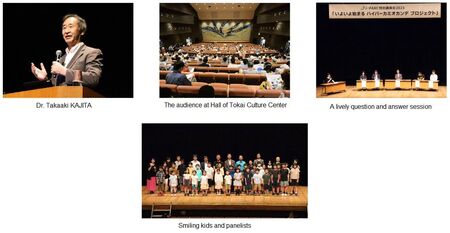 In-person PR activities for J-PARC have restarted after being strongly suppressed by the COVID pandemic over the past three years.
In-person PR activities for J-PARC have restarted after being strongly suppressed by the COVID pandemic over the past three years.
On July 1, 2023, J-PARC held a "Special Lecture" for the general public, especially local residents, inviting Professor Kajita, Novel laureate for physics in 2015, as the main speaker. The lecture was held at the Tokai Culture Center and had approximately 400 in-person attendees and 2,700 views on YouTube.
J-PARC has also started a joint project with the village of Tokai to investigate the interior of an ancient tomb located in Tokai village using J-PARC's muon radiography technology. Muon radiography uses cosmic muons to investigate the thickness of an object by measuring the penetration of muons. A unique aspect of this project is that it involves working with local junior high school, high school, and even elementary school students. The project started in FY2023, and during the first half of the year, various lectures were given to the students. Construction of the muon tracking detector will begin in the second half of the year. https://j-parc.jp/symposium/special_lecture2023/
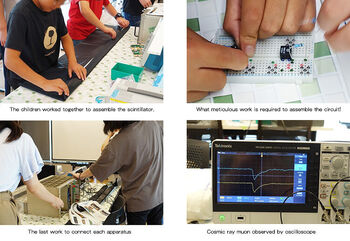
https://j-parc.jp/c/topics/2023/08/24001193.html
https://j-parc.jp/c/topics/2023/09/29001217.html
https://j-parc.jp/c/topics/2023/09/29001217.html
https://www.vill.tokai.ibaraki.jp/soshikikarasagasu/kyoikuiinkai/shogaigakushuka/9/1/2/8705.html
☆-------------------------------------------------------------------------------------------------…
2. [Accelerator Division] by Michikazu KINSHO
…-------------------------------------------------------------------------------------------------★
-------------------------------------------------------------------------------------------------
STATUS OF THE ACCELERATORS
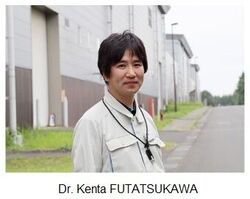 We are pleased to announce that Dr. Futatsukawa, in charge of low-level radio frequency (LLRF) for the J-PARC Linac, received the 19th Particle Accelerator Society of Japan Award for Technological Contribution (http://www.pasj.jp/award.html, in Japanese).
We are pleased to announce that Dr. Futatsukawa, in charge of low-level radio frequency (LLRF) for the J-PARC Linac, received the 19th Particle Accelerator Society of Japan Award for Technological Contribution (http://www.pasj.jp/award.html, in Japanese).
The operation of the J-PARC accelerator was suspended on June 22nd due to a fire, and the summer's maintenance period then started.
Some major tasks in the maintenance period are described below.
In all the Accelerator facilities, to prevent the reoccurrence of the fire, the integrity of all power supplies was investigated, and more interlocks were reinforced.
At the 3-GeV synchrotron (RCS), two conventional radio frequency (RF) cavities are being replaced with a new type of cavities (single-ended cavities) to be completed by mid-October. After finishing this work, three of the 12 conventional RF cavities in the RCS would have been replaced, and the remaining 9 cavities will be done in five years.
At the main ring (MR), a set of power supply systems is being adjusted in parallel with the usual tasks in the maintenance. It is progressing well towards the MR beam study operation in November. An RF cavity was added and the power supply for the RF system was expanded. After these tasks are completed, the MR is expected to be able to stably accelerate beams of 750 kW or more.
The beam tuning at the Linac will start at the beginning of November. The beam operation for the MLF users will start in the middle of November after the beam tuning in the RCS.
☆-------------------------------------------------------------------------------------------------…
3. [Particle and Nuclear Physics Division]
…-------------------------------------------------------------------------------------------------★
-------------------------------------------------------------------------------------------------
ON THE FIRE IN THE POWER SUPPLY BUILDING OF THE HADRON EXPERIMENTAL
FACILITY (by Takeshi KOMATSUBARA)
-------------------------------------------------------------------------------------------------
As described in [Overview] by the J-PARC Director, we investigated the cause of the fire in the Hadron Power Supply Building on Thursday, June 22nd, countermeasures were established and the final report was submitted to the local governments on October 23rd and 24th.
The user beam time before summer maintenance was reduced from 60 days to 44.5 days for MLF users and from 58 days to 12 days for MR users. After safety check, MLF/Neutrino operation are planned to resume in late November; while countermeasures in the Hadron Experimental Facility will continue; it will take more time to resume the Hadron operation.
We, once again, deeply apologize to the users for the serious delay and reduction of user beam.
-------------------------------------------------------------------------------------------------
PROGRAM ADVISORY COMMITTEE MEETING (by Takeshi KOMATSUBARA)
-------------------------------------------------------------------------------------------------
The 36th Program Advisory Committee (PAC) meeting was held as a hybrid conference on July 19-21. The two fire incidents in this Fiscal Year were explained, the status of the experiments was reported, and prospects for the program from the autumn onwards were discussed. This time two new proposals for experiments with neutron beams at MLF were also submitted.
https://kds.kek.jp/indico/event/47390/
The PAC report will be available through the following web page.
http://j-parc.jp/researcher/Hadron/en/PAC_for_NuclPart_e.html
The next PAC meeting will be held in January 2024.
This meeting was the last one chaired by Dr. Rik Yoshida (Argonne National Laboratory), who has been the PAC chair since April 2018 including during the difficult times of the COVID-19 era. We are sincerely grateful for his dedication to the J-PARC physics program.
-------------------------------------------------------------------------------------------------
NEW RESULTS FROM THE KOTO EXPERIMENT (by Tadashi NOMURA)
-------------------------------------------------------------------------------------------------
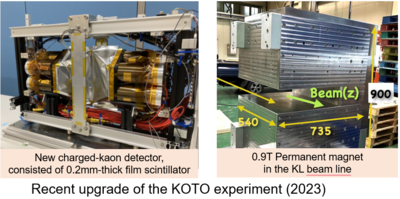 The E14/KOTO experiment at the Hadron Experimental Facility aims to search for the decay of long-lived neutral kaon into a neutral pion and a neutrino-antineutrino pair. This process breaks CP symmetry and is highly suppressed in the Standard Model, which predicts its branching ratio to be 3e-11. It has not been observed yet experimentally in the world. The key to the success of the experiment is background suppression.
The E14/KOTO experiment at the Hadron Experimental Facility aims to search for the decay of long-lived neutral kaon into a neutral pion and a neutrino-antineutrino pair. This process breaks CP symmetry and is highly suppressed in the Standard Model, which predicts its branching ratio to be 3e-11. It has not been observed yet experimentally in the world. The key to the success of the experiment is background suppression.
In the analysis of data taken in 2016-18, KOTO found new background sources, the major one of which was a small contamination of charged kaons in the neutral beam. Since then, KOTO has improved the detector and developed new analysis methods to reduce backgrounds. For example, a new charged-particle counter has been installed in 2020 and upgraded in 2021 to detect charged kaons.
KOTO had been carefully analyzing data taken in 2021 and finalized the analysis this summer. The number of background events was estimated to be 0.255, with the single event sensitivity of 8.7e-10. After all the event selections, no signal candidates were observed. As a result, a new upper limit for the branching ratio is set preliminarily to be 2.0e-9 at the 90% confidence level, which is the world-best limit of this search.
KOTO has first reported this result at a KEK IPNS and J-PARC Joint Invited Seminar on September 6. See details in the slides on https://kds.kek.jp/event/47838/.
-------------------------------------------------------------------------------------------------
PREPARING FOR THE UPCOMING NEUTRINO BEAM TIME OF NOVEMBER-DECEMBER
(by Yoshiaki FUJII)
-------------------------------------------------------------------------------------------------
Though the first beam operation in April was quite short, it gave us precious information on the upgraded/replaced beam line components.
The new electro-magnetic horns for focusing and the new bending magnet for targeting functioned as designed. On the other hand, we could not establish full understanding of the new beam orbit.
The second beam operation scheduled from June 23rd was canceled due to the power supply fire in the Hadron Experimental Facility, and we moved to the summer maintenance period In the summer work, the primary beam line team is focusing their effort on beam monitors and alignment of equipment.
There are three horns installed in the beamline. The new version of the third horn was built at University of Colorado, delivered to J-PARC, and finishing process and final tuning was done. Excitation test is coming soon.
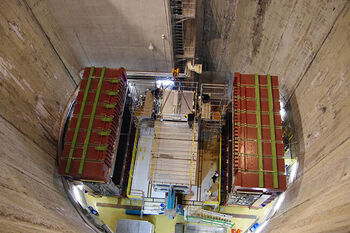 T2K experimental group held a face-to-face collaboration meeting at J-PARC in July, and over 100 members attended. They published a paper on the updated results of the neutrino oscillation analysis. The installation of upgraded detectors at the ND280 site has finally begun. Two Time-of-Flight detectors were installed in July. The bottom High-Angle TPC was delivered to J-PARC in August and successfully installed in September. We will install the SuperFGD in October and close the magnet in November to be ready for the first data taking with upgraded detectors.
T2K experimental group held a face-to-face collaboration meeting at J-PARC in July, and over 100 members attended. They published a paper on the updated results of the neutrino oscillation analysis. The installation of upgraded detectors at the ND280 site has finally begun. Two Time-of-Flight detectors were installed in July. The bottom High-Angle TPC was delivered to J-PARC in August and successfully installed in September. We will install the SuperFGD in October and close the magnet in November to be ready for the first data taking with upgraded detectors.
-------------------------------------------------------------------------------------------------
STATUS OF THE JSNS2 / JSNS2-II (SEARCH FOR STERILE NEUTRINOS AT J-PARC MLF, E56 / E82)
(by Takasumi MARUYAMA)
-------------------------------------------------------------------------------------------------
The JSNS2 (E56) / JSNS2-II (E82) collaboration searches for neutrino oscillation by sterile neutrinos over a short distance at J-PARC MLF.
For JSNS2, the fourth long physics run from Dec-2023 to June-2024 using a single near detector located on the third floor of MLF is being prepared. For JSNS2-II, a new far detector is under construction. 172 10-inch PMTs out of 228 in total, which corresponds to all PMTs except for the cosmic ray veto region, were installed in the far detector by end of Aug-2023. The acrylic I-Beams which are the support structure of the acrylic tank were installed in the detector in advance. The installation of the acrylic tank will be performed soon. JSNS2-II aims to start the data taking within FY2023.
-------------------------------------------------------------------------------------------------
STATUS OF THE COHERENT MUON TO ELECTRON TRANSITION (COMET) (by Satoshi MIHARA)
-------------------------------------------------------------------------------------------------
The COMET experiment aims to search for the lepton-flavor violating muon reaction, mu-e conversion, with a sensitivity better than 10-14 in Phase I. In February and March 2023, the COMET group carried out an engineering run, called Phase alpha, to measure the behavior of the proton beam and of the secondary particles. Detailed data analysis is in progress to evaluate muon momentum distribution produced backward by 8GeV proton beam.
In parallel to this activity, facility construction continues. The capture solenoid magnet used to collect pions and transport them to the beam transport magnet is assembled at the manufacturer. Withstand voltage test was repeated to confirm the coil secureness before the final assembly in the cryostat. The detector solenoid construction is in progress to be installed in the COMET experiment area in 2024. Conditionings/setups of Phase I detectors such as Cylindrical Drift Chamber, Cylindrical Trigger Hodoscope, Straw-tube tracker, and LYSO calorimeter are in progress at J-PARC and collaborating institutes.
-------------------------------------------------------------------------------------------------
STATUS OF THE MUON g-2/ ELECTRIC DIPOLE MOMENT (EDM) (E34) (by Tsutomu MIBE)
-------------------------------------------------------------------------------------------------
The E34 collaboration aims for precision measurements of the muon anomalous magnetic moment and its electric dipole moment. The collaboration worked on magnetic field monitor in the vicinity of the muonium production target as well as data analysis of the laser ionization of muonium at the MLF S2 area. Preparation for the laser room as well as the platform for the RF power supplies are in progress. The engineering design of the MLF extension building, the H-line experimental bldg., is in progress.
The collaboration submitted a document to summarize the replies to the comments and recommendations of the IPNS progress review committee for the muon g-2/EDM experiment.
☆-------------------------------------------------------------------------------------------------…
4. [Materials and Life Science Division]
…-------------------------------------------------------------------------------------------------★
-------------------------------------------------------------------------------------------------
Neutron Source; ONGOING MAINTENANCE WORKS DURING THE LONG OUTAGE (by Katsuhiro HAGA)
-------------------------------------------------------------------------------------------------
The beam operation of MLF ended on June 22nd and the maintenance works during the long outage started. On July 6th, the used mercury target vessel, which was in operation from 2017 to 2018, was transported from MLF to the storage building, (the so-called RAM building) where a total of 6 used target vessels are stored by now.
On September 4th, specimens were cut out successfully from the fore front wall of the used target vessel which was operated for the long-term user program with the highest beam intensity recorded of 950 kW, for the beam power at the outlet of RCS. The maximum damage depth on the specimens will be measured soon and the beam power for the next user program will be decided. On September 13th, the used mercury target vessel was replaced with a new one which had the improved structure of the mercury flow channel. That is to say, the bubble generator was split into two parts and the position was moved forward by 200 mm to get closer to the beam window. It enables the bubble number density to be larger near the beam window contributing to less pitting damage on the inner wall to allow for beam operation with higher power.
-------------------------------------------------------------------------------------------------
Neutron Instruments and Science; OPERATIONAL SCHEDULE FOR THE NEXT PERIOD OF 2023B CYCLE DISCUSSED
2023B CYCLE DISCUSSED (by Mitsutaka NAKAMURA)
-------------------------------------------------------------------------------------------------
The 2023A operation was forced to stop beam delivery on June 22nd due to a fire incident at Hadron facility. Initially the experimental period was scheduled to end on June 26th. Then, the period of long summer shut down started. The good news is that neutron users are totally back after COVID-19 disaster. 289 neutron experiments proposals for next operation cycle 2023B, were submitted. 175 proposals have been approved for the next operational time of 80 days in the period of 2023B. Though we have only limited beam time, all the operational schedule has been discussed at the MLF Advisory Board on August 29th. 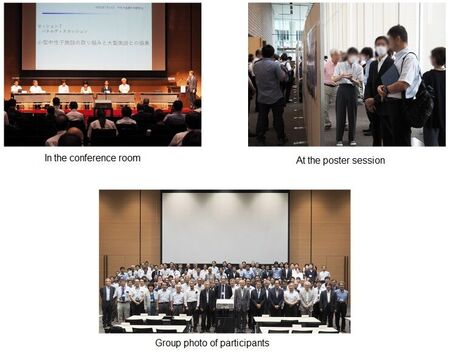 The 6th Annual Meeting on Industrial Application for Neutron was held at the Convention Hall in Akihabara on the 13th and14th of July. In order to respond to requests from the industrial community (to know what we can see and how we can use neutrons and muons), the main purpose is the matching what the industrial community would like to see to what we can see with neutrons and muons. The meeting was held in a hybrid format with 225 (on-site) and 114 (online) participants.
The 6th Annual Meeting on Industrial Application for Neutron was held at the Convention Hall in Akihabara on the 13th and14th of July. In order to respond to requests from the industrial community (to know what we can see and how we can use neutrons and muons), the main purpose is the matching what the industrial community would like to see to what we can see with neutrons and muons. The meeting was held in a hybrid format with 225 (on-site) and 114 (online) participants.
Recent press releases from MLF:
BL15 TAIKAN on Aug. 22
"Polarized Neutrons Observed Nanometer-thick Crystalline Ice Plates in Frozen Glucose Solution"
https://doi.org/10.1021/acs.jpclett.3c01448
BL19 TAKUMI on Aug. 15
"Strengthening of a Mg and Long-period Stacking Ordered Phases in a Mg-Zn-Y Allow by Hot-extrusion with Low Extrusion Ratio"
https://doi.org/10.1016/j.actamat.2023.119029
 BL02 DNA on Jul. 26
BL02 DNA on Jul. 26
"Quasi-elastic Neutron Scattering Studies on Fast Dynamics of Water Molecules in Tetra-n-butylammonium Bromide Semiclathrate Hydrate"
https://doi.org/10.1063/5.0157560
BL09 SPICA on Jul. 7
"New Design Rule for High-entropy Superionic Solid-State Conductors"
https://www.j-parc.jp/c//en/press-release/2023/07/07001178.html
-------------------------------------------------------------------------------------------------
Muon Science Facility (MUSE); MUON EXPERIMENT PROPOSALS FOR 2023B ROUND (by Naritoshi KAWAMURA)
-------------------------------------------------------------------------------------------------
The new proposal round 2023B is for the period from November to March 2024. The Muon Science Proposal Review Committee (MSPRC) meeting reviewed 64 proposals; 34 were approved, 25 reserved, and the remainder not approved; 4 proposals categorized in the carry-over category are to be performed also in the 2023B cycle.
The user experiments were smoothly performed before the stoppage due to the fire incident in the Hadron facility. The canceled users' programs for about a week will be compensated in the 2023B cycle as carry-over programs. The issue prompted an emergency security survey of the magnet power supplies and other electrical equipment in MUSE by the beginning of August. So far, the 2023B cycle is planned to start as scheduled.
In the S line, the Kapton debris left in the beamline were retrieved,. The fracturing of the Kapton foil separating the primary and the secondary beamline vacuum caused the operation to stop for a month last year. A detailed analysis will be performed on the collected debris to determine the origin of the breaking to prevent its recurrence.
The 19th PASJ (Particle Accelerator Society of Japan) Award for Research Encouragement was awarded to Dr. Yuga Nakazawa for "Development of a muon linac for the J-PARC muon g−2/EDM experiment".
☆-------------------------------------------------------------------------------------------------…
5. [Nuclear Transmutation Division]by Shin-ichiro MEIGO
…-------------------------------------------------------------------------------------------------★
-------------------------------------------------------------------------------------------------
WORKSHOP ON J-PARC PROTON BEAM IRRADIATION FACILITY
-------------------------------------------------------------------------------------------------
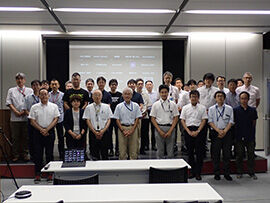 On July 27, a workshop on "J-PARC Proton Beam Irradiation Facility" was held as an in-person and online hybrid mode. There were 94 participants, with 32 in-person and 62 online. After addressing the status of nuclear transmutation research and the primary mission of the facility to promote that research, the expectations and needs of the facility were presented for four potential research fields, i.e., material irradiation damage, semiconductor soft error testing, RI production for medical applications, and proton beam applications. The needs of the user community of this facility, which were established after a previous workshop held last year, coupled with additional needs presented in this workshop, were discussed. The current status of the facility design to satisfy the users' needs was presented. In the end, the road map for the construction of the facility was discussed.
On July 27, a workshop on "J-PARC Proton Beam Irradiation Facility" was held as an in-person and online hybrid mode. There were 94 participants, with 32 in-person and 62 online. After addressing the status of nuclear transmutation research and the primary mission of the facility to promote that research, the expectations and needs of the facility were presented for four potential research fields, i.e., material irradiation damage, semiconductor soft error testing, RI production for medical applications, and proton beam applications. The needs of the user community of this facility, which were established after a previous workshop held last year, coupled with additional needs presented in this workshop, were discussed. The current status of the facility design to satisfy the users' needs was presented. In the end, the road map for the construction of the facility was discussed.
☆-------------------------------------------------------------------------------------------------…
6. [Editorial Note]
…-------------------------------------------------------------------------------------------------★
Past issues are available from the link below.
http://j-parc.jp/c/en/topics/project-newsletter/index.html
┏----…----…----…----…----…----…----…----…----…----…----…----…☆
┃ Editorial Board:
┃ Hidetomo OGURI (Chair) : oguri.hidetomo[at]jaea.go.jp
┃ Katsuhiro SHINTO: shinto.katsuhiro[at]jaea.go.jp
┃ Kyoichiro OZAWA: ozawa[at]post.kek.jp
┃ Kyoko AIZAWA: akyouko[at]post.j-parc.jp
┃ Hayanori TAKEI: takei.hayanori[at]jaea.go.jp
┃ Jean-Michel POUTISSOU (English Editor): jmp[at]triumf.ca
┃ Chiaki SHIRAISHI (Secretary): shiraishi.chiaki[at]jaea.go.jp
┃ * Please replace "(at)" with "@" when you enter an email address.
★----…----…----…----…End of Letter…----…----…----…----…----





